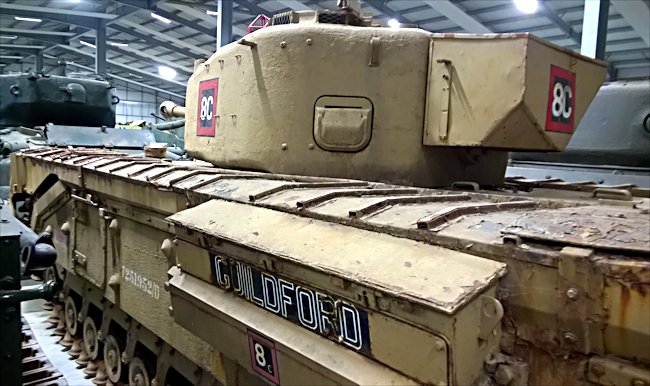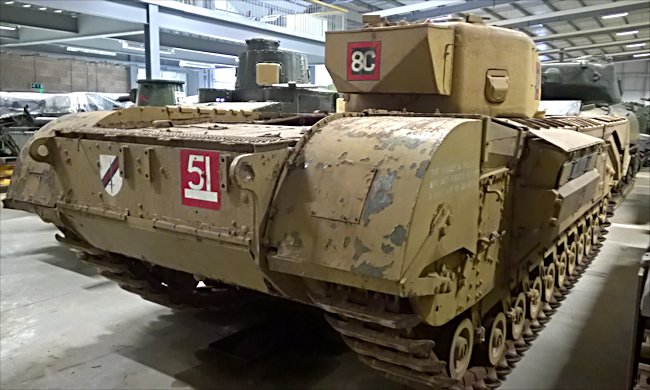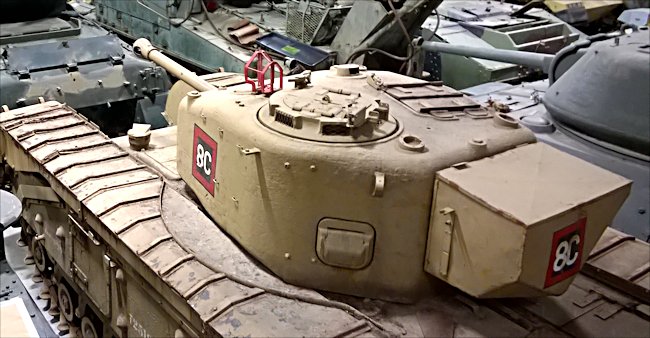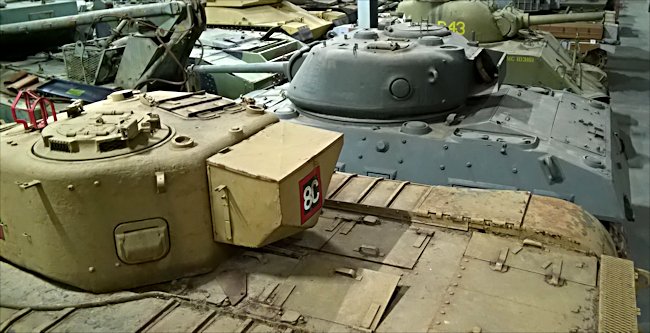The British Churchill MkIV 75mm A22 Infantry Tank
This British Churchill Mark IV tank can be found at the Tank Museum, Bovington, Dorset, England. It is presently awaiting restoration.

Side view of the British Churchill MkIV Infantry Tank called Guildford
The Mark IV version of the Churchill Infantry tank was the most numerous type that was produced during World War Two. It is believed that 1,622 were manufactured. It was very similar to the previous Mark III except that it was fitted with the cheaper to produce cast turret. A 6 pounder gun was fitted with a counter weight on earlier models but this was later upgraded to the 75 mm gun.
The tracks on this version of the Churchill tank are fully covered on the top unlike earlier versions. It appears to be an earlier tank that has upgraded to Mark IV specifications. The Churchill A22 infantry tank looks like it has more connections with the World War One tanks than those of the 1940's. Yes it was designed to be slow moving, heavily armoured and give support to attacking infantry units but this tank started to shine. It was up armoured and up gunned during the war. It could take a lot of punishment from enemy anti-tank guns and knock out Italian and German tanks and gun emplacements. Its long body length meant that it had excellent cross country qualities. It could cross virtually any anti tank trench and rough terrain put in its way. It may be slow but at least it would get there eventually.

British Churchill MkIV Infantry Tank rear view
This Churchill MkIV tank is currently painted in a North African Desert campaign paint scheme. Six of these tanks were recorded as being successfully used during the second Battle of El-Alamein in Libya with the British and Commonwealth 8th Army forces. The served with distinction in the push into Tunisia. Their good hill climbing abilities cam in handy not only in the desert but later in Italy.
This tank was used as a gate guardian at the Bovinton Tank Museum and has suffered from the exposure to the British weather. It has not got the expected 6-pounder (57mm) gun fitted in the turret. Instead it has they more powerful British 75mm gun installed in a cast turret. You can tell it is a Mark IV Churchill because the ventilator is mounted centrally above the driver's position and not slightly off centre as on the MkVII tanks when an additional drivers periscope was fitted. Also on the later model Churchill tanks the protective armour around the driver's vision hatch was more of a rectangular, bolted and welded arrangement rather than on the earlier models that wer more rounded indicating that it was cast.

Commanders cupola view on the turret of a British Churchill MkIV Infantry Tank
What seems out of place on this tank is the commanders ARV cupola which is not a standard feature of the MkIV. One explanation for this was it could have been part of an in theatre modification. Like wise it has some suspension feature that you would expect to find on a MkVII tank. Tanks were not scrapped when they got damaged. The mechanics repaired them with what spares they had at the depot. It makes sense that if possible new and improved parts would be used if they fitted and were available. like wise some other parts of this tank come from MkIII Churchill tanks.

Engine hatch covers on a British Churchill MkIV Infantry Tank
WW2 Tank Books

